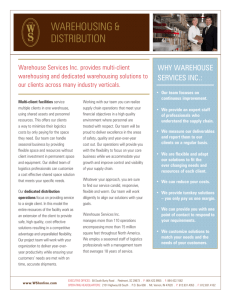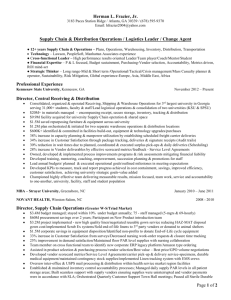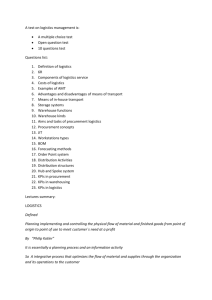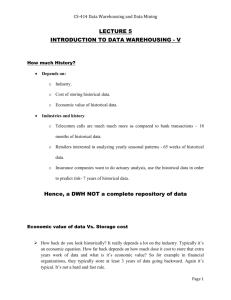TTL 124 Outline - Clackamas Community College
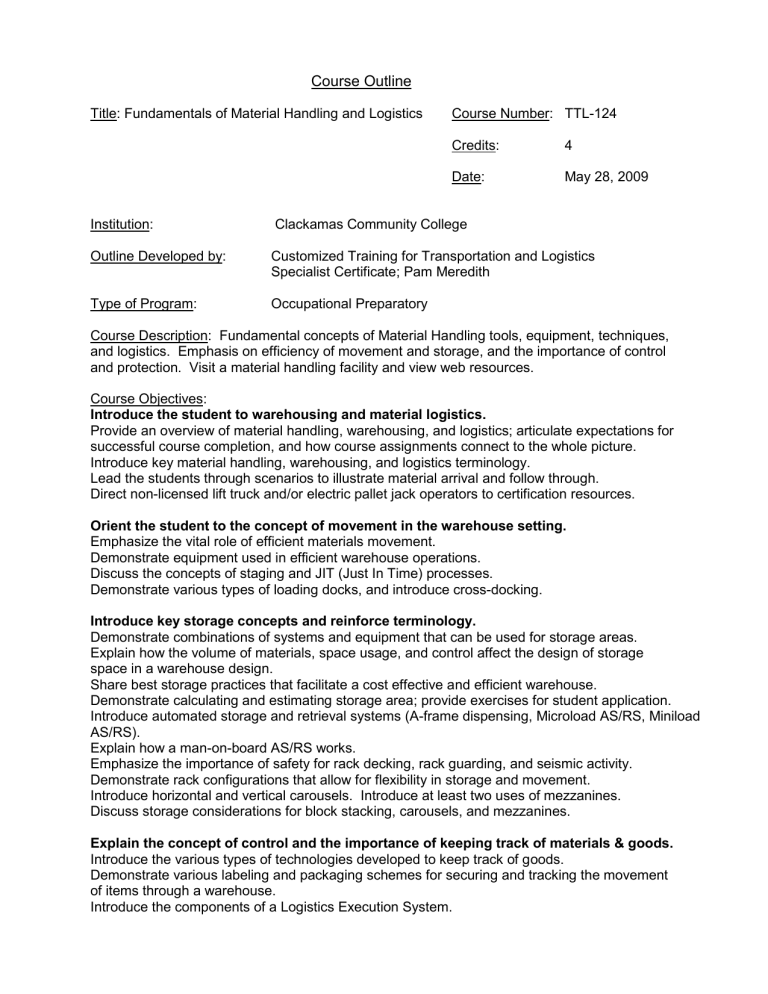
Course Outline
Title: Fundamentals of Material Handling and Logistics Course Number: TTL-124
Credits:
Date:
4
May 28, 2009
Institution: Clackamas Community College
Outline Developed by: Customized Training for Transportation and Logistics
Specialist Certificate; Pam Meredith
Type of Program: Occupational Preparatory
Course Description: Fundamental concepts of Material Handling tools, equipment, techniques, and logistics. Emphasis on efficiency of movement and storage, and the importance of control and protection. Visit a material handling facility and view web resources.
Course Objectives:
Introduce the student to warehousing and material logistics.
Provide an overview of material handling, warehousing, and logistics; articulate expectations for successful course completion, and how course assignments connect to the whole picture.
Introduce key material handling, warehousing, and logistics terminology.
Lead the students through scenarios to illustrate material arrival and follow through.
Direct non-licensed lift truck and/or electric pallet jack operators to certification resources.
Orient the student to the concept of movement in the warehouse setting.
Emphasize the vital role of efficient materials movement.
Demonstrate equipment used in efficient warehouse operations.
Discuss the concepts of staging and JIT (Just In Time) processes.
Demonstrate various types of loading docks, and introduce cross-docking.
Introduce key storage concepts and reinforce terminology.
Demonstrate combinations of systems and equipment that can be used for storage areas.
Explain how the volume of materials, space usage, and control affect the design of storage space in a warehouse design.
Share best storage practices that facilitate a cost effective and efficient warehouse.
Demonstrate calculating and estimating storage area; provide exercises for student application.
Introduce automated storage and retrieval systems (A-frame dispensing, Microload AS/RS, Miniload
AS/RS).
Explain how a man-on-board AS/RS works.
Emphasize the importance of safety for rack decking, rack guarding, and seismic activity.
Demonstrate rack configurations that allow for flexibility in storage and movement.
Introduce horizontal and vertical carousels. Introduce at least two uses of mezzanines.
Discuss storage considerations for block stacking, carousels, and mezzanines.
Explain the concept of control and the importance of keeping track of materials & goods.
Introduce the various types of technologies developed to keep track of goods.
Demonstrate various labeling and packaging schemes for securing and tracking the movement of items through a warehouse.
Introduce the components of a Logistics Execution System.
Introduce Radio Frequency Identification, and other devices used in automatic data capture.
Discuss the importance of automation in warehousing.
Clarify the role that protection plays in the total concept of “warehousing”.
Demonstrate forms of unit load formation equipment that can be used for protecting materials.
Discuss types of load containment materials.
Explain the need and means for protecting warehouse personnel.
Identify advantages/disadvantages of open-air or soft-walls for protection of warehoused items.
Illustrate ways to protect goods in the loading dock area.
Compare a pallet to a skid.
Discuss relative advantages for using containers, crating, pallets, wrapping and netting.
Discuss ergonomics associated with warehouse equipment.
Host (or co-host) a field trip to a material handling facility.
Provide an overview of the material handling facility layout.
Point out material handling logistics during the tour.
Emphasize safety, ergonomics, movement, storage, control, and protection elements.
Encourage the students to observe various movements within the warehouse, and evaluate relative efficiencies.
Encourage students to observe cost-efficient measures, and report discoveries during the tour.
Encourage students to think about opportunities to improve movement or cost-effectiveness.
Provide time for the material handling facility co-host to introduce/answer site-specific or industry questions and speak to key concepts they want to emphasize.
Debrief class post-tour; review and discuss key emphasis and encouragement elements.
Introduce the student to external opportunities to explore Material Handling and Logistics.
Articulate expectations for student term paper, utilizing three or more external sources.
Assign a case study for students to pull together Material Handling and Logistics concepts learned in class.
Introduce students to professional organization and resources available via the web.
Provide lab time for students to explore sites.
Emphasize continuous improvement, resources available beyond class. (examples below:) www.aapa-ports.org
American Association of Port Authorities www.truckline.com
American Trucking Associations www.apics.org
Association for Operations Management
(Advancing Productivity, Innovation, &
Competitive Success) www.cemanet.org
Conveyor Equipment Manufacturers Organization www.indtrk.org
Industrial Truck Association www.iarw.org
www.iwla.com
International Association of Refrigerated Warehouses
International Warehouse Logistics Association www.sole.org
www.ism.ws
International Society of Logistics
Institute for Supply Management www.mhia.org
Material Handling Industry of America www.truckload.org
Truckload Carriers Association www.werc.org
Warehousing and Education Research Council
Student Learning Outcomes:
Upon successful completion of this course, the student should able to:
Define material handling logistics as it applies to the warehousing function.
Identify three critical scenarios that can happen to material arriving at a warehouse.
Seek licensing resources for lift trucks and/or electric pallet jacks.
Explain the concept of movement and the vital role that efficient movement of materials plays in the total functionality of the warehouse.
Identify various types of equipment and docking available to enhance efficient movement within a warehouse.
Identify the combinations of systems and equipment that can be used to support storage areas in a warehouse.
Explain how the volume of materials, space usage, and control affect the design of storage space in a warehouse design.
Given a scenario, determine the best storage opportunity.
Explain the importance of safety in rack decking, rack guarding, and seismic activity.
Recognize automated storage and retrieval systems.
Differentiate storage considerations for block stacking, carousels, and mezzanines.
Calculate and estimate storage area.
Define control as it applies to warehousing.
Identify the various types of technologies developed to keep track of goods.
Identify various labeling and packaging schemes for securing and tracking the movement of items through a warehouse.
Define the components of a Logistics Execution System.
Define Radio Frequency Identification, and other devices used in automatic data capture.
Explain the importance of automation in warehousing.
Explain the relationship between physical structure and protection.
Identify ways to protect goods in the loading dock area.
Compare a pallet to a skid.
Identify key containers, crafting, pallets, wrappers, and netting techniques.
Recognize warehouse safety and ergonomic practices.
Utilize key resources to assist in continuous improvement and learning.
Length of Course: 40 lecture hours
Grading Method: Letter grade (A-F) or Pass/No Pass
Prerequisites:
Recommended:
None
RD-090
Required Text: Fundamentals of Warehousing & Distribution , by Allan Howie,
©2008 Material Handling Industry of America.
Major Topic Outline:
1. Warehousing, Material Handling, and Logistics Concepts a. Major functions of material handling b. Logistics introduction and definition c. Warehouse movement, storage, and control d. Relationship between physical structure and protection
2. Movement a. Efficient movement b. Warehouse locations planned for efficient movement c. Types of equipment available to enhance efficient movement d. Staging, JIT (Just In Time), Cross Docking
3. Storage a. Best practices b. Calculating and estimating storage area c. Key storage-related terminology d. Block stacking, carousels, mezzanines e. Configuring a pallet rack
4. Control a. Importance of keeping track of materials and goods b. Technologies available to help track goods c. Labeling and packaging schemes d. Logistics execution systems e. Signage and signposting f. Magnetic devices used in automatic data capture g. Radio frequency identification h. Warehouse automation
5. Protection a. Protection role in warehousing b. Unit load formation equipment c. Load containment materials d. Open-air vs. soft-wall warehousing e. Protecting goods in the loading dock area f. Containers, crafting, pallets, netting and wrapping; pallets vs. skids g. Ergonomics and warehouse equipment
6. Additional resources a. Related web sites b. Professional Associations and Organizations
7. Terminology a. Case b. Control i. Material handling logistics j. Movement c. Cross Docking d. Density e. Empty weight f. Information-filled labeling g. Lift table h. Logical/Logistics k. Narrow Aisle l. Pallet lift and turntable m. Pallet tilter n. Pallets o. Peaks and Valleys p. Protection q. Real time r. Sinage/signposting s. Size t. Stacking frame u. Staging v. Storage w. Tare weight x. Vacuum lifter y. Volume z. Warehousing
8. Acronyms a. AS/RS(Automated Storage/Retrieval System) d. LES (Logistics Execution System) b. JIT (Just In Time) e. RFID (Radio Frequency Identification) c. FIFO (First In, First Out) f. SKU (Stock Keeping Unit)
g. VLM (Vertical Lift Modules)

